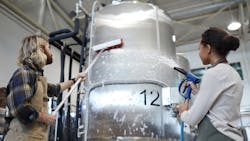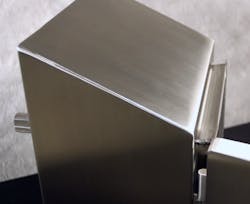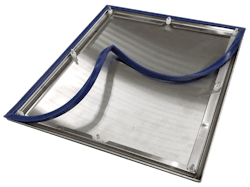Rarely does anything good come of mixing water and general electronic components. In fact, most electronics need to be protected from dust, chemicals and other contaminants. In challenging environments such as processing facilities, on-board machinery or any place where devices need to be shielded from the elements, installing them in a properly rated enclosure is a straightforward method to do this.
For some applications, however, it is just as important to consider the space external to the enclosure. This applies to pharmaceutical, clean room and food and beverage processing applications — all of which have stringent requirements for keeping areas clean and avoiding product contamination.
This article addresses the details and options that designers need to be familiar with when selecting enclosures to prevent harming both what is inside and outside of the box.
More to protect
Just as cookware and bakeware is used in the kitchen to prepare food, industrial-size operations producing food, beverages and pharmaceuticals rely on vessels, hoppers, pipes, tanks and other equipment for processing the products. Electrical and automation enclosures are normally not designed to be in contact with these products, but they are certainly in the vicinity. And just like kitchenware needs to be cleaned, industrial processing equipment is also cleaned — but via high-pressure washdowns, chemicals and other heavy-duty processes — so enclosures may be in the splash zone.
These processes are increasingly automated, requiring additional electronic components, along with enclosures. Some types of instrumentation, input/output modules and other automation components are built to work directly in washdown environments without a separate enclosure, but a large percentage must be installed in control panels. Most programmable logic controllers (PLCs) are intended to mount inside enclosures, as are the associated human-machine interface (HMI) devices.
Improved networking media and protocols, the proliferation of new sensors, vision systems and other automation advancements, and a desire to reduce costly conduit and wire in the field have combined such that today’s systems may have many more control panels than ever before, distributed throughout a machine or larger installation.
Even if an enclosure can withstand the washdown conditions, it must have features such that it will not contaminate the environment later. For instance, nooks and crannies on the enclosure exterior could harbor dirt or bacteria, which could accumulate and cause a problem. Some operations must be carried out in specially conditioned clean rooms. For these locations, it is imperative that enclosure materials never off-gas or leach into the area.
Checking all the right boxes
As designers consider their enclosure choices for a hygienic or sanitary application, there are several areas they should investigate:
- Ratings and standards
- Enclosure materials and finish
- External physical configuration
- Hardware and accessory options
- Gasketing
- Mounting provisions
Enclosures intended for installation in hygienic or sanitary locations will likely undergo washdowns. Washdown procedures may include high-pressure streams, hot water and/or various chemicals, including acids, caustic solutions or solvents. Even if they are not washed with powerful jets, they may be cleaned and wiped down with some fluid solution. In North America, the typical rating for withstanding pressurized water streams is NEMA 4, and if corrosive or caustic chemicals are involved, the required rating is NEMA 4X. European IP ratings are not directly equivalent, but enclosures rated IP65, IP66, IP66K and IP69K resist increasingly powerful water jets, and IP69K includes resistance to water up at temperatures up to 176°F.
Industry standards, such as NSF/ANSI 3A and 169, address hygiene requirements for certain industries such as meat and poultry processing or special food processing. Other industries may have their own standards. The U.S. Food and Drug Administration (FDA) also has applicable requirements. Standards describe how enclosures should be fabricated, other construction features and how they should be used for hygienic service.
While there are exceptions, most enclosures for hygienic use typically rely on 300-series stainless steel for external materials, most commonly with a #4 finish brushed finish. Coatings are possible, but they can introduce the chance of chipping, peeling or chemical leaching. Metallic coatings may be allowable for internal fittings, but not for the exterior. The finish needs to resist corrosion and avoid any texture that could harbor bacteria development.
Physically, hygienic enclosures must shed liquids so they cannot collect anywhere. Enclosure tops are commonly sloped, and the door has a run-off channel or gutter protecting its opening. Since these gutters are also sloped for drainage, the opening of the enclosure may have a peculiar appearance, as the shape of the opening is not rectangular as with standard enclosures. Seams are welded and finished to be smooth. All edges, even for exposed fittings, are rounded to facilitate cleaning. No exposed threads or other convoluted surfaces are allowed.
Enclosures may use hex-head bolts for the external-facing fasteners, instead of slotted or Phillips screw heads, which have embedded grooves. Internally, the hinges are often designed to make the door edges easily cleanable while installed and to be readily disassembled for routine deep cleaning.
While the metal enclosure walls and door easily keep water out, the heavy work of resisting moisture intrusion falls to the gasketing material clamped between the door and the enclosure body. Some enclosures may have a permanent inboard gasket plus a second outboard gasket intended to be serviceable. The outboard external-facing gasket must resist aggressive cleaning, chemicals and high-temperature pressure washes — while remaining compliant with FDA requirements and flexible for long use in the closed position.
Silicone is a popular material for this service, and this gasket material may be press-in replaceable to ease maintenance. Avoiding adhesives makes the gasket easy to replace and avoids another way that the environment could potentially be contaminated. Some enclosure designs use blue silicone so that any contamination is more easily spotted during cleaning.
Mounting provisions and hardware are subject to the same considerations as the enclosure itself. The connection points must be gasketed or otherwise protected. Wall-mount enclosures should have stand-offs so the enclosure is spaced away from the wall at least 2 inches and can be cleaned on the back side. Floor-mount enclosures require legs at least 6 inches tall for the same reasons.
Hygienic enclosures will not come with any penetrations, as panel shops and field installers will create these as needed depending on the installed devices and raceways. Conduits are rarely installed as top-entry due to washdown concerns, even if the fittings are suitably rated. Sometimes, installers may use weld-in-place procedures to avoid using extra hardware or making additional penetrations.
Enclosures protect both the inside and the outside
An industrial enclosure can be just a simple box to protect relatively delicate contents. However, for hygienic and sanitary applications in many industries, enclosure selection takes on much more importance to keep liquids and chemicals out and to keep the surrounding environment impeccably clean.
The increasing number of sensors, proliferation of intelligent devices and increased automation signaling — combined with a desire to minimize field wiring by networking many remote devices — is increasing the need for field-installed enclosures. When designers understand all the technical options and can choose from a large portfolio of products and accessories, they can find the best fit for all these situations.
Jody T. Kinney, PE, is a product manager at AutomationDirect. He is responsible for market analysis and strategy, product selection and supplier relations for electrical enclosures, enclosure thermal management products and related tools. Kinney has a B.S. in mechanical engineering with High Honors from the Georgia Institute of Technology. He has more than 32 years of experience in design, construction, manufacturing, laboratory analysis, forensic engineering and product management.
About the Author
Jody Kinney
Jody T. Kinney, PE, is a product manager at AutomationDirect. He is responsible for market analysis and strategy, product selection and supplier relations for electrical enclosures, enclosure thermal management products and related tools. Kinney has a B.S. in mechanical engineering with High Honors from the Georgia Institute of Technology. He has more than 32 years of experience in design, construction, manufacturing, laboratory analysis, forensic engineering and product management.


